What will you see and do in Japan?
Cities & Towns
Large city
Old city & town
Traditonal Structures
Japanese castle
Shinto shrine & Buddhist temple
Japanese garden
Cultures & Arts
Traditonal culture
Traditonal art
Traditonal craft
Manga & Anime
Nature & Onsen
Sea & Islands
Mountains, Rivers & Lakes
Plants & Animals
Onsen resorts
Large cities
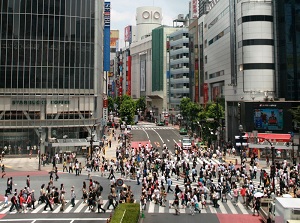
Shibuya in Tokyo
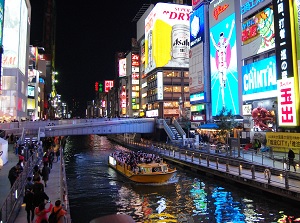
Dotonbori in Osaka
There are 12 large cities with over one million in population in Japan.
Tokyo is the capital of Japan and it is overwhelming big.
It has a population of over ten million and the number is about ten percent of the total population of Japan.
The large cities are the center of each region in Japan, and they are the entrances of your travel in the region.
In addition, because the city is the center of the culture in the region, there are various sightseeing spots in the city.
Old cities & towns
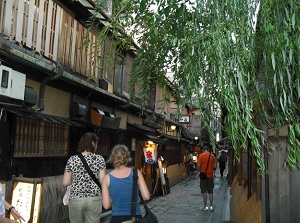
A street of Gion in Kyoto
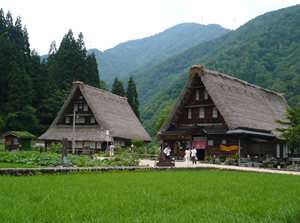
Shirakawa-go in Gifu Pref.
In the Middle Ages, many samurai warriors were dotted in all parts of Japan except Hokkaido and Okinawa islands and they reigned his territory as feudal lord.
They built the castle in the central area, and the samurais serving the lord lived around the castle.
After that, merchants and craftsmen gathered there, and castle towns were formed.
Many local cities in Japan have such histories and some cities preserve the historic atmosphere.
Japanese castles
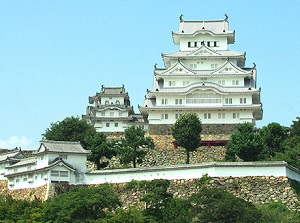
Himeji Castle in Hyogo Pref.
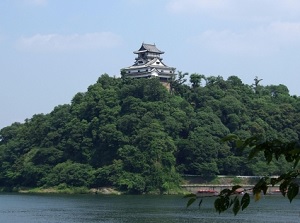
Inuyama Castle in Aichi Pref.
Japanese castles were built in the 15th to 17th centuries.
Main castles became the center of local government, and castle towns were formed around the castle.
After the feudal times ended in 1868, many castles had been demolished.
Japanese castle is a symbol of the city, and demolished castles were rebuilt in many cities in the 20th century.
Shinto shrines & Buddhist temples
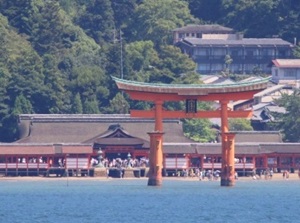
Itsukushima Shrine in Hiroshima Pref.
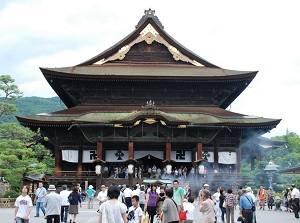
Zenkoji Temple in Nagano Pref.
"Shinto" originated as indigenous religion when ancient Japan was formed around the 6th century.
It is rooted deeply in the mind of Japanese people.
On the other hand, "Buddhism" was introduced from China in the 6th century.
It also has been believed widely in Japan.
Both religions are not opposed to each other, and most Japanese people accept both in everyday life.
(Therefore, Japanese people are relatively tolerant of the other religions such as Christianity, Islam.)
There are many Shinto shrines and Buddhist temples throughout Japan.
Visiting historical shrines and temples has been a style of travel to sacred place for Japanese people.
Japanese gardens
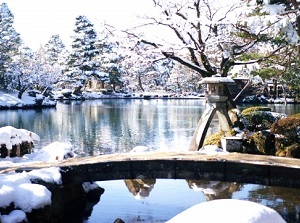
Kenrokuen in winter in Ishikawa Pref.
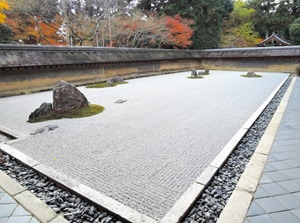
Sekitei garden of Ryoanji Temple in Kyoto
Japanese gardens had been builted in castles, temples, and rich residences as a part of the buildings.
Chinese garden was roots of Japanese garden, but Japanese garden emphasizes natural beauty.
They are also the view point of the spots.
Japanese traditional culture
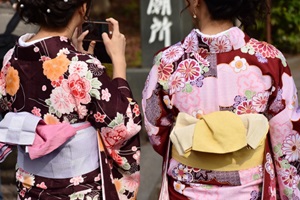
In the ancient times, emperors and court nobles had governed the nation.
Samurai guarding them had seized political power since around the 10th century.
In the early 17th century, a stable nation by samurai and citizenes started.
Samurai and Ninja worked for the government.
The main cloths were Kimono, and calligraphy by brush was the main method of writing.
Tea ceremony developed as the necessary accomplishments of a samurai, and Flower arranment also spread in the citizen.
And the citizens had created various unique entertainments during Edo Period in the isolated location in the world.
Kabuki, Noh, Bunraku are the such peforming art, and Sumo developed as a show of sport.
These are seen as Japanese traditonal culture, and they have been handed down.
You can see or experience them in various place in Japan.
You can check them in the following pages.
Japanese traditional arts
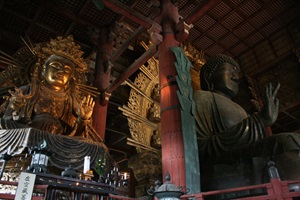
In the 6th century, Buddhism was introduced to Japan from China by way of Korea.
Buddhist paintings and Buddhist statues are the origin of Japanese art.
The arts developed as times changed.
And various unique arts were created in Edo Period.
These are seen in many museums, and we can find in the historical places such as Buddhist temples, castles, etc.
Traditional Japanese sculpture are mainly Buddhist statues.
But there are various kinds of sculptures.
Traditional Japanese pictorial arts originate Buddhist paintings.
They were influenced by Chinese art in the middle age, and Japan's own pictorial arts were created.
Japanese traditional crafts
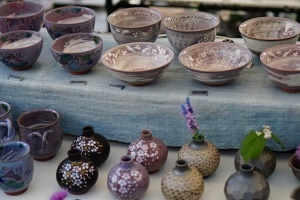
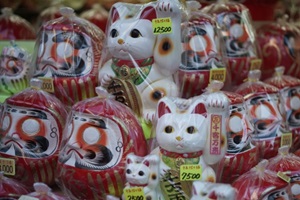
Ceramic art, Lacquerware have been produced as tools used in daily life since ancient times.
The works had received influence from overseas and the needs of the times in the middle age, so various types of the works have been produced in Japan.
Traditional textiles have developed for Kimono.
The weaving and dying have the traditional skills and techniques.
Japanese sword is well-known as the symbol of samurai.
It is also an art object as traditional craft.
And there are various traditional goods for your souvenirs.
Manga and Anime
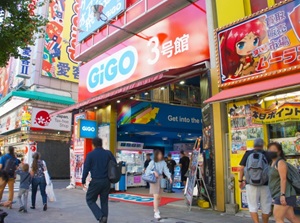
Akihabara in Tokyo
Manga and Anime have become an international word for comics, cartoon or animation of Japan.
In Japan, the word of "Manga" is mainly used for the pictures on the comics.
And the word "Anime" (shortened form of "animation") is used for the moving image.
In any bookstore, there is a manga section and a lot of manga books and magazines are sold.
In addition, Video games, Cosplay, Maid cafes have been derived from manga and anime.
Nature & Onsen in Japan

Mt.Fuji & Lake Ashi in Hakone
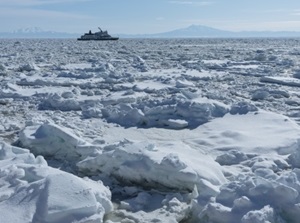
Drift ice of Okhotsk Sea in Hokkaido
Sea and Islands in Japan
Japan consists of over 14,000 islands.
The mainland consists of four large island, and they account for over 95% of the whole of Japan.
The other small islands are around the mainland and some of them are dotted on a line in the vast ocean.
The islands spread in wide area.
The territory reaches from subarctic zone to subtropical zone.
Because of such geographical features, various climates appear by region.
Mountains, Rivers, Lakes in Japan
The mainland is mountainous and forests cover many areas.
The mountainous districts occupy 70% of the land, so Japanese people live in the narrow flat lands.
Rivers flowing out from the mountains are short.
The rapid streams, gorges and waterfalls are seen in many area.
Plants & Animals in Japan
In such land, there are various fields and forests and various plants and animals are seen.
Onsen resorts in Japan
There are about 1,500 active volcanoes in the world, and 111 of them are in Japan.
As the benefit of them, there are many hot springs (Onsen in Japanese).
Visiting Onsen has been one of popular leisures of Japanese people since the old times.

